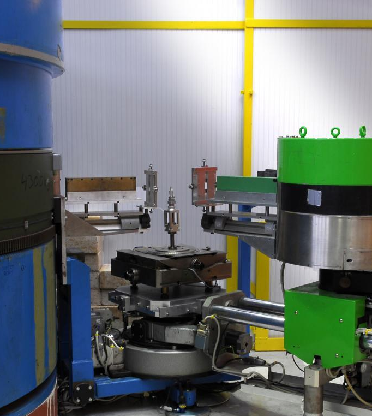Thermal Neutron Three-axis Spectometer and Neutron Holographic Instrument (TAST)
Budapest Neutron Centre

The thermal neutron three-axis spectrometer (TAST) of BNC is installed on the thermal neutron channel No.8 at the Budapest Research Reactor. The instrument provides (~1.0 meV) moderate resolution with sufficient intensity for use in a wide range of problems. It is ideally suited for the study of phonon and magnon dispersion in single crystals, phonon density of states for a wide range of materials, which contain hydrogen. Independent control of the momentum (Q) and of the energy transfer (E) is a routine, if required, as opposed to Time-Of-Flight spectrometers in which Q and E are related by the instrumental configuration. The TAST/HOLO triple axis spectrometer can also be used in a multi-purpose regime, e.g. for high-resolution diffractometry, inelastic scattering as well as for thermal beam irradiation and transmission tests as well as tests of neutron optical components of various kinds.
The monochromatic beam is provided by a horizontally and vertically focusing Cu[002] monochromator of 90mm height and 150mm width. In order to suppress the intensity of fast neutrons, a 15 cm long sapphire single crystal is inserted in the primary shutter. A Ge analyzer can be optionally used for higher order filtering in the incident monochromatic beam. The beam divergence is determined by thin film Soller-type Mylar collimators coated with Gd2O3 .
A highly efficient (90% at 1 Å) 3He single counter of 1” diameter is applied as detector. A two-dimensional position-sensitive detector is also available to use in medium resolution mode. For energy analysis a horizontally focusing pyrolytic graphite crystal assembly is used.
The spectrometer can be equipped by an Eulerian Cradle, or a tilt table that can hold various sample environments up to a mass of 100 kg. In 2005 the TAST instrument was upgraded to be optionally used for atomic resolution neutron holography in neutron- or gamma-ray detection modes. A BGO gamma detector is available with a proper shielding to filter the rather high gamma background of the environment and detect the low intensity holographic signal.
Contact: tast@bnc.hu
Technical specifications
| Beam Tube: | Channel No. 8. (radial channel with sapphire filter) |
| Monochromator: | Cu[002], horizontally and vertically focusing |
| Analyzer: | Pyrolitic graphite 002 (horizontally focusing) |
| Detector: | 3He tube |
| Range of monochromator angle: | 14°<2Θ<90° |
| Range of analyzer angle: | -100°<2Θ<120° |
| Angular precision: | 0.01° |
| Flux at sample at 1A wavelength: | 2×106n/cm2/sec |
| Beam size: | 50×50/10×15 nm2 depending on focusing |
| Momentum transfer range: | 1.5-10A-1 |
| Energy transfer range: | 1-60 meV |
Detailed information can be found on the instrument’s webpage.



